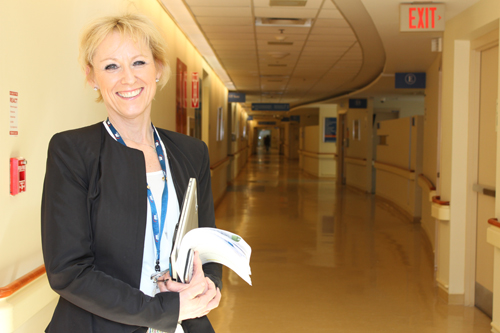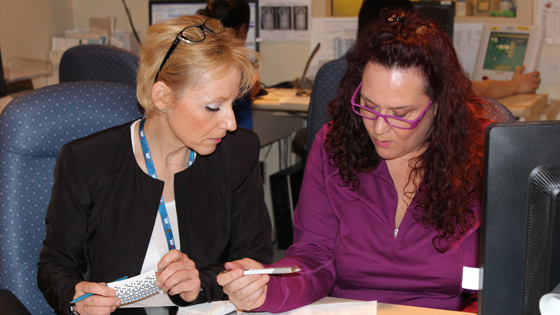
As JDMI’s Patient Flow Coordinator (PFC), Karen MacDonald is working to streamline communication to help improve the patient experience. (Photo: UHN)
Within a few short months, Karen MacDonald has become a full-fledged communicator, educator and detective.
These are choice words she uses to describe her role as Patient Flow Coordinator (PFC) for the Joint Department of Medical Imaging (JDMI) at Toronto General Hospital.
"It's about putting the pieces of the puzzle together," says Karen.
A new position for the JDMI, Karen stepped foot in these shoes in December 2014 to help streamline communication across wards and improve imaging access for patients.
"So far it's been a very positive experience with lots of learning opportunities and progress made in improving our department's connection with patients and staff," she says.
Karen works with various hospital services including surgery, multi-organ transplant, ER and general internal medicine, helping to expedite urgent in-patient scans and – for those whose procedures can wait and be organized for a later date – discharging in-patients to be sent home in the meantime.
The communicator
"By sharing knowledge and being fully involved in the hospital network at all levels, I get a sense of where the hospital stands and which patients are in the queue," explains Karen. "I can make rearrangements to help the medical teams plan effective care for patients."
Karen's daily interaction with other hospital areas helps ensure that medical imaging has a face. She's become a welcomed – and critical – component to bridging the gap in the JDMI's patient care process.
"Until now, we haven't been able to speak with our referring TGH clinicians to understand their patients' context – this was an important missing component when triaging a patient," says Paul Cornacchione, Clinical Director, JDMI.
"Karen's role allows us to see the greater hospital landscape, so we can make more informed decisions when prioritizing scans and addressing our patients' needs."
While Karen collaborates with referring physicians and their teams to gather and provide clinical information about each patient, she also uses this knowledge to work closely with JDMI's radiologists and technologists in order to protocol and reclassify patient requests.
"As our radiologists continue to sort cases based on clinical indications, I help provide context to the cases," says Karen. "Knowing our patients' clinical history allows the medical imaging teams to determine the most appropriate order of cases."

MacDonald emphasizes collaboration and teamwork as essential to the work she does in her role. (Photo: UHN)
The educator
As Medical Imaging's PFC, Karen also helps improve the patient care process by delivering educational awareness to the floors of TGH. She provides advice on how to identify the best scan for patients and how to properly prep patients for their medical imaging procedures.
"Many of the hospital units rely on our ability to scan patients quickly and accurately," shares Karen. "When a tube is out of place or the wrong scan is requested, this disrupts the diagnostic and therapeutic process, which can hinder the patient's care and slow the entire patient flow throughout the department."
By sharing medical imaging best practices with TGH staff, Karen aims to improve efficiency throughout the hospital.
In doing so, she also hopes to shed some light on the complexity of her department.
"What we do is very unique and revolutionary – from its highly technical aspect, to the diagnosis and treatment," she says. "If I can help other areas understand what our needs are for achieving the best scan possible, and what is gained from having this test or procedure, it will be a better experience for the patient."
The detective – just one piece of the puzzle
"I have to do a bit of digging at times," laughs Karen.
She stresses the importance of making informed decisions. If situations arise where a scan is requested incorrectly, or an urgent request to treat a patient comes through, Karen investigates further in order to analyze the patient's situation fully and act accordingly.
"This is where I work with everyone involved in the patient's care – from the referring physicians, their medical teams and the other clinical coordinators, to our radiologists, modality supervisors, medical radiation technologists and medical imaging nursing team – to piece together the story and explain why something happened or what appropriate action should take place," she says.
Above all else, Karen is quick to emphasize collaboration and teamwork are essential to making this role work.
"It takes an entire team of medical expertise to successfully plan a patient's pathway," she says. "The more education you give to the health care providers and those within the patient's circle of care, and vice versa, the better experience it becomes for the patient."
Karen pioneering this role is only the beginning of a long line of plans for the JDMI.
"The development of Karen as Patient Flow Coordinator is another step in building the JDMI's patient-centred approach," says Paul. "We're hoping to create more roles like hers in the future, to help support our greater vision of 'Exceptional Quality, Exceptional Care'.
